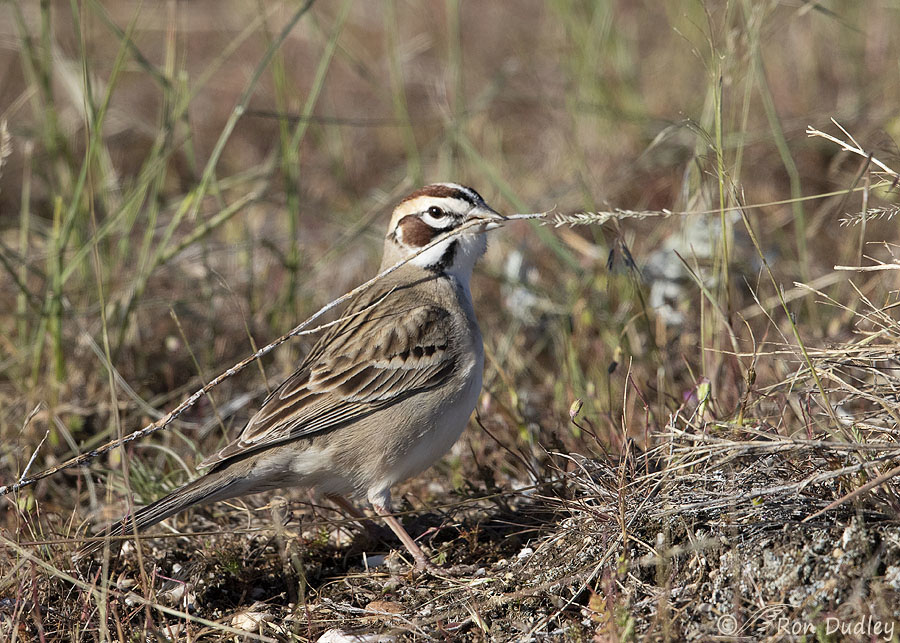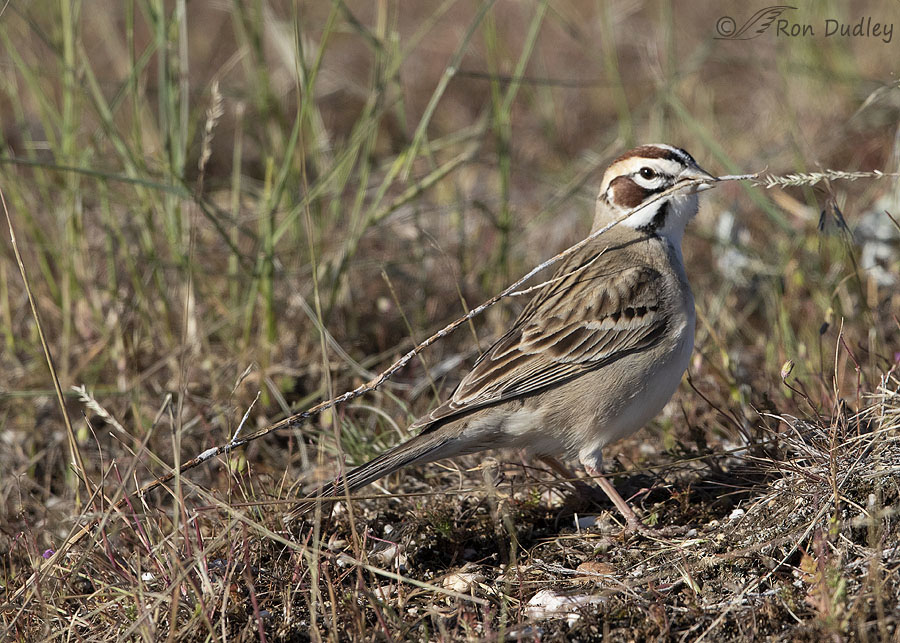Perhaps the epitome of “biting off more than you can chew.”
The only way I can visit Antelope Island this spring is through my older photos. This one was taken in May of 2016. I posted other images of this sparrow four years ago but this one is new to my blog.

1/2500, f/6.3, ISO 500, Canon 7D Mark II, Canon EF 500mm f/4L IS II USM + EF 1.4 III Extender, not baited, set up or called in
Male and female Lark Sparrows are similar but since only females build nests my presumption is that this bird is a female. I watched her through my lens as she was obviously searching for something in the grasses. During the nesting season they eat both insects and seeds so at first I figured she was foraging for food but instead she picked up this long, thin twig.
Her attempt to drag the twig through the thick vegetation was epic. The twig kept hanging up in the grasses but she was determined to get it into a clear spot where it was no longer entangled so she could fly off with it. Here she paused for a moment to assess the situation.

A different crop of the same photo gives us a better sense of just how long the twig really was and why it kept hanging up in the vegetation. There’s even more of the twig out of frame at lower left.
It really was a nearly impossible task and even though she worked at it for quite a while she eventually gave up and flew off without the twig. There would be many hundreds of pieces of nesting material in her nest by the time she completed it and she would have done all of that work without any help from her mate.
I’m exhausted just thinking about it.
Ron


Beautiful bird and interesting behavior. I took photos of a Lark Sparrow in NE Illinois from some distance. When I reviewed them I noticed “she” (thanks for that info) was carrying nest material in some of the images. This led to discovery of the first nest ever documented nesting in Kane County.
Whoah, she is a beauty! And determined!
Thanks, Ron, for such a stunning photo of one of my favorite sparrows. I share my life with three parrots, and when they molt I toss those discarded feathers into the front yard. Always neat to see one of their feathers recycled in somebody’s nest.
“I share my life with three parrots”
Wow, you must live an interesting (and noisy) life, Diane. Sounds fun.
Like both…a lot!
Thanks, Patty.
Yet another hardworking charmer. I loved Marty’s comment about using that twig to beat her partner about the head. Which took my wandering mind back to childhood. My father used to chastise our German Shepherd with a blade of grass for her sins. She yelped every time.
That made me chuckle, EC. The fact that your dog was a German Shepherd enhanced my enjoyment of it.
Wondering if she wanted that twig for her nest or to thrash her mate for not helping around the house. 😉
Fabulous shot and thank you for including both crops. It gives me more of an idea as to some of the decisions you make in front of your computer. I’d be interested in a “Cropping for Dummies” tutorial if you ever want to do one. (I seriously have no idea what I’m doing when I try to crop something on my phone.)
Hmmm, Cropping For Dummies sounds like a potential blog post one day. Thanks for the idea, Marty.
The making of a nest by any bird just amazes me. From a hummingbird to a Bald eagle building a nest is a work of art. A lucky bird is one that has a helpful partner 😁
Agreed, Diana. Male Lark sparrows must have it comparatively easy.
I am impressed that you caught the Lark Sparrow in the act of nest gathering. To me it indicates the time and attention you give to your photography.
A very distinctive sparrow. Wish we had them here; just to be able to name that one would really up my passerine ID sklls☺️
The twig gathering reminds me of my home construction projects. All she has to do is drop her selection if it isn’t the right size. For me it means yet another trip to the lumber yard.
Ha, I know what you mean about home construction projects. When the clerk at Lowe’s asks me if I found everything I needed I always say “I won’t know until I get home”.
Good Response – like plumbing supplies – at least one more trip to town! 😉
Every time you see something like this it reminds you just how remarkable nature is. In the early spring if I am outback doing some landscape work I will often leave small twigs rather than do a complete cleanup. Fun watching the birds pick them up when nesting season starts. Nice photo – although pretty much just brown and white the Lark is a pretty bird.
Everett, I always used to have gajillions of little twigs laying around in my yard before I had my huge elm tree cut down. The birds may miss that tree but I sure as hell don’t.
She DID have “grand plans”….. 🙂 Kind of like human’s “lazy man’s load” 😉 It’s always interesting what they will try to/actually succeed at incorporating in their nests…. Wonderful job of isolating her in the photo. 🙂
Don’t think I’ve seen or heard “lazy man’s load” used since my Montana days, Judy. Made me smile…
Always interesting about “local” sayings………. 🙂
Love the sharpness of the sparrow here, especially the side view of her head. I enjoy studying and comparing the differences in their markings…the difficult part at first is finding that one or two points that stand out to make a quick ID in the field. This bird/your photo of it is great for that purpose. So many little sparrows…so much to remember… 🙂
“I enjoy studying and comparing the differences in their markings”
Kathy, the facial markings of this sparrow are quite unique. Some folks call it the Harlequin Sparrow because of those markings.
Wonderful photo! It’s a lot easier to see and photograph a large bird with a simple background, like a cormorant in water, trying to take off with a too-big piece of nesting material. You’ve made the subject stand out amazingly well by controlling the depth of field and waiting until there was a relatively simple spot behind the birds head. Tough subject, great job.
“You’ve made the subject stand out amazingly well by controlling the depth of field and waiting until there was a relatively simple spot behind the birds head”
Now that’s an insightful observation, Nancy. That’s exactly what I did.
I just love this. Bird behavior’s as interesting to me as their appearance is beautiful, and nesting season is one time when it’s especially compelling. I recently watching a starling try to deal with a dried section of palm frond that had fallen to the ground. When it finally got airborne, I couldn’t believe it — the bit of frond had to be five times the length of the bird.
“the bit of frond had to be five times the length of the bird”
I’ve seen birds doing similar things, Shoreacres. It’s amazing that they can remain airborne with such large and cumbersome “baggage”.